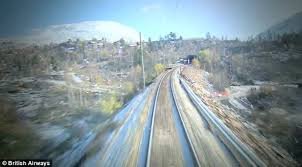Competition with Air
Bullet Train

Competition with Air
Over the past decades, passenger transport has undergone important changes concerning the modal distribution of demand. The dominant position of the railways began to lose its leading foothold in favour of the plane, for long distances, and of the private vehicle, for shorter distances. This has been as a result of the loss of competitiveness of the traditional train in relation to other transportation services, originating from travel times far superior to those of alternative modes.
In this context, the high speed train was introduced as a new form of understanding railway transport, notably improving the quality of service offered. This investment will affect the generalised costs related to the alternatives and may generate a redistribution of journeys between them, varying the existing modal distribution. The aim of this article is to evaluate the potential of the future high speed train to compete with current demand for the airline service in Spain. The physical and supply characteristics of existing transport portray the Madrid Barcelona route as an optimal setting for this aim. Firstly, it will connect the two capital cities with the greatest number of inhabitants in the country, with 4.7 million inhabitants in the case of Barcelona and 5.1 million in Madrid. On the other hand, the 620
kilometres between them suppose an extremely interesting line for a high speed investment,reducing the length of the train journey from the current approximately six hours to two and a half or three hours, thus converting it into the fastest land transport on this route. The impact of this investment on the demand for airline travel is quite uncertain and of great interest, given that the run analysed offers the frequency of the most competitive flights in the country, reaching timetables with departures every 15 minutes. The potential capacity of the future high speed train to compete on this market is analysed in this article. Demand modelling is developed in a hypothetical context, allowing for this alternative to be characterised, in spite of it not being available in reality. Experimental design techniques are applied which, based on the information collected, will allow for the estimation of a probabilistic choice model, so as to collect and characterise the preferences of passengers concerning alternatives for travel. With this information, it will be possible to predict the behaviour of passengers in the near future and to simulate different policy options for transport supply. The monetary value of the different types of time associated travel is also derived. The expansive policy predicted within Europe in high speed infrastructures supposes the commitment of a huge amount of resources. Therefore, it is important to have the necessary information available so that this allocation may be efficiently achieved. In this sense, the results of this article may be extended to other contexts.
 Public versus private funding Japan
Public versus private funding Japan From bullet trains to subways Lessons from Japan
From bullet trains to subways Lessons from Japan China Train Types
China Train Types Benefits of high speed Train
Benefits of high speed Train Future of bullet train
Future of bullet train India
India Early research
Early research Environmental objections in path of bullet train California
Environmental objections in path of bullet train California Competition with Air
Competition with Air Bullet Train Technologies
Bullet Train Technologies Facilities Onboard
Facilities Onboard Economic Impact
Economic Impact Test your English Language
Test your English Language  Benefits of Cucumber
Benefits of Cucumber Benefits of Thyme
Benefits of Thyme Myth about Adoption
Myth about Adoption Celebration of Nag Panchami
Celebration of Nag Panchami New Years Food Ideas
New Years Food Ideas What to Eat in Maharashtra
What to Eat in Maharashtra Popular Men Deodorant Brands
Popular Men Deodorant Brands Management Tips
Management Tips Benefits of Bitter Gourd
Benefits of Bitter Gourd




